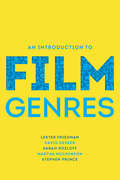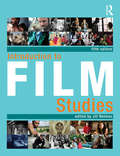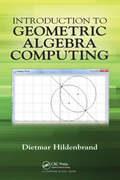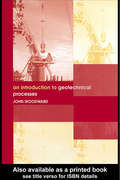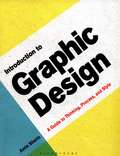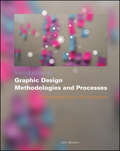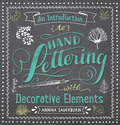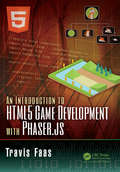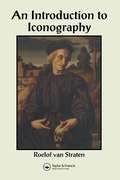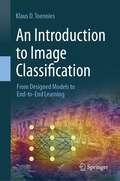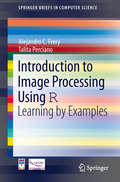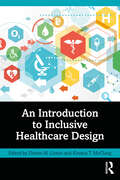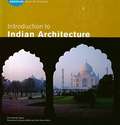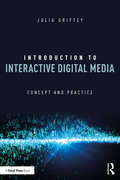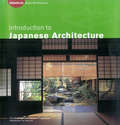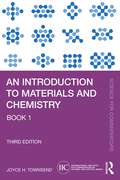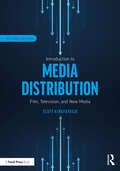- Table View
- List View
An Introduction to Film and TV Production: From Concept to Market
by Joseph Richie Karen Russell Airielle J. Taylor Tameka WinstonThis streamlined, step-by-step guide provides students and newcomers in the field of media with an overview of the complete production process, from conceiving of an idea to marketing the final product. Readers will learn what it takes to create a concept, develop it, and then market and sell it. Chapters discuss pitching, producing, marketing visionary concepts, financing, and distributing content. Focused on traditional and non-traditional platforms including social media, websites, and online advertising, this book explores currently evolving media platforms, ideas, and practices and provides examples of how to navigate these unique creative processes. Interviews with business executives offer insider tips and tricks to creating a marketable project. In this book, you will learn how to: Distinguish between a "great idea" and a "marketable idea." Condense your concept into an effective "elevator pitch." Build a basic business plan. Create a marketing strategy, be it traditional, digital, or both. Establish a personal brand and portfolio that will grab the right attention. This book will be of great help to the student, independent filmmaker, and content creator looking to understand the process of getting their work produced, distributed, and marketed.
An Introduction to Film Genres (First Edition)
by Sarah Kozloff Stephen Prince David Desser Lester Friedman Martha NochimsonA brisk, accessible, and informative introduction to film genres. An Introduction to Film Genres, written by leading film scholars specifically for undergraduates who are new to the study of film, provides an introduction that helps students see thirteen film genres in a new light---to help them identify the themes, iconography, and distinctive stylistic traits of each genre. This purchase offers access to the digital ebook only
Introduction to Film Studies, 5th edition: An Introduction To Film Studies
by Bill Nichols Jill NelmesIntroduction to Film Studies is a comprehensive textbook for students of cinema. This completely revised and updated fifth edition guides students through the key issues and concepts in film studies, traces the historical development of film and introduces some of the worlds key national cinemas. A range of theories and theorists are presented from Formalism to Feminism, from Eisenstein to Deleuze. Each chapter is written by a subject specialist, including two new authors for the fifth edition. A wide range of films are analysed and discussed. It is lavishly illustrated with 150 film stills and production shots, in full colour throughout. Reviewed widely by teachers in the field and with a foreword by Bill Nichols, it will be essential reading for any introductory student of film and media studies or the visual arts worldwide. Key features of the fifth edition are: updated coverage of a wide range of concepts, theories and issues in film studies in-depth discussion of the contemporary film industry and technological changes new chapters on Film and Technology and Latin American Cinema new case studies on films such as District 9, Grizzly Man, Amores Perros, Avatar, Made in Dagenham and many others marginal key terms, notes, cross-referencing suggestions for further reading, further viewing and a comprehensive glossary and bibliography a new, improved companion website including popular case studies and chapters from previous editions (including chapters on German Cinema and The French New Wave), links to supporting sites, clips, questions and useful resources. Individual chapters include: The Industrial Contexts of Film Production · Film and Technology · Getting to the Bigger · Picture Film Form and Narrative · Spectator, Audience and Response · Cinematic authorship and the film auteur · Stardom and Hollywood Cinema · Genre, Theory and Hollywood Cinema The Documentary Form · The Language of Animation · Gender and Film · Lesbian and Gay Cinema · Spectacle, Stereotypes and Films of the African Diaspora · British Cinema · Indian Cinema · Latin American Cinema · Soviet Montage Cinema of the 1920s Contributors: Linda Craig, Lalitha Gopalan, Terri Francis, Chris Jones, Mark Joyce, Searle Kochberg, Lawrence Napper, Jill Nelmes, Patrick Phillips, Suzanne Speidel, Paul Ward, Paul Watson, Paul Wells and William Wittington
Introduction to Geometric Algebra Computing: Computing with Circles and Lines (Computer Vision Series)
by Dietmar HildenbrandFrom the Foreword: "Dietmar Hildenbrand's new book, Introduction to Geometric Algebra Computing, in my view, fills an important gap in Clifford's geometric algebra literature…I can only congratulate the author for the daring simplicity of his novel educational approach taken in this book, consequently combined with hands on computer based exploration. Without noticing, the active reader will thus educate himself in elementary geometric algebra algorithm development, geometrically intuitive, highly comprehensible, and fully optimized." --Eckhard Hitzer, International Christian University, Tokyo, Japan Geometric Algebra is a very powerful mathematical system for an easy and intuitive treatment of geometry, but the community working with it is still very small. The main goal of this book is to close this gap with an introduction to Geometric Algebra from an engineering/computing perspective. This book is intended to give a rapid introduction to computing with Geometric Algebra and its power for geometric modeling. From the geometric objects point of view, it focuses on the most basic ones, namely points, lines and circles. This algebra is called Compass Ruler Algebra, since it is comparable to working with a compass and ruler. The book explores how to compute with these geometric objects, and their geometric operations and transformations, in a very intuitive way. The book follows a top-down approach, and while it focuses on 2D, it is also easily expandable to 3D computations. Algebra in engineering applications such as computer graphics, computer vision and robotics are also covered.
An Introduction to Geotechnical Processes
by John WoodwardThe study of the solid part of the earth on which structures are built is an essential part of the training of a civil engineer. Geotechnical processes such as drilling, pumping and injection techniques enhance the viability of many construction processes by improving ground conditions.Highlighting the ground investigation necessary for the process
Introduction to Graphic Design: A Guide to Thinking, Process and Style (Required Reading Range #74)
by Aaris SherinFor a great foundation as a graphic design student, look no further than Aaris Sherin's Introduction to Graphic Design. Sherin will introduce you to the formal structure of graphic design, so you can understand and utilise the main techniques of your chosen profession, and learn how they apply to print and screen-based projects. Whether you need to conceptualise a new poster, develop an exciting advertisement, structure an app or create eye-catching signage, chapters can be read in any order you choose, depending on which area you wish to concentrate. <p><p> Whatever your approach, you'll be encouraged to use critical thinking, visual exploration and understand the special relationship graphic designers have to creative problem solving. There are also chapters devoted to imagery, color, and typography, using a thematic approach to creative problem-solving. With over 500 images showing examples from international designers, helpful diagrams, highlighted key terms and concepts, Design in Action case studies, exercises and chapter-by-chapter Dos and Don'ts, Introduction to Graphic Design will give newcomers to graphic design the confidence to give visual form to concepts and ideas.
Introduction to Graphic Design Methodologies and Processes
by John BowersA concise, visually based introduction to graphic design methodologies Graphic design has emerged as a discipline complete with a body of scholarly literature devoted to its underlying theory. Introduction to Graphic Design Methodologies and Processes contributes to this expanding discourse by illustrating the value of qualitative and quantitative methodologies in guiding conceptual development in ways beyond those based on taste, style, and personal preference. Introduction to Graphic Design Methodologies and Processes: Introduces a range of practical methodologies pertinent to the interpreting, targeting, and creating of forms and messages Furthers the ability of designers by showing them how to design creatively, collaboratively, and strategically, and as a result, helps them move from form-makers to cultural participants-a transformative trend for design professionals Includes case studies with questions and answers contributed by a diverse group, including Second Story and Sol Sender As professional designers play more strategic roles, the need for material on design methodologies is growing. This concise, visually based introduction to the topic is the designer's definitive resource for defining their purpose, and producing work that is original, appropriate, responsible-and inspiring.
An Introduction to Hand Lettering with Decorative Elements (Lettering, Calligraphy, Typography)
by Annika SauerbornA treasure trove of lettering styles and decorative elements, this handy reference offers an abundance of eye-catching alphabets, numerals, ribbons, borders, flowers, banners, and other easy-to-trace embellishments. With this guide, it's easy to add a personal touch—humorous, dramatic, or romantic—to any handwritten message or meditative journal.Hundreds of ornaments, all of them hand-drawn by the author, include dozens of alphabets and numerals. You'll also find frames, flourishes, and corner designs that provide pages with a stylish finishing touch. Decorative motifs range from arrows, hearts, and stars to leaves, blossoms, and wreaths. A wealth of fanciful graphics for special occasions includes designs for birthdays, weddings, holidays, and all four seasons. Calligraphers, crafters, and illustrators as well as anyone who wants to add a bit of pizzazz to their writing will prize this imaginative source of inspiration.
An Introduction to HTML5 Game Development with Phaser.js
by Travis FaasExperience the thrill of crafting your own HTML5 game with Phaser.js game engine. HTML5 and modern JavaScript game engines have helped revolutionized web based games. Each chapter in An Introduction to HTML5 Game Development with Phaser.js showcases a sample game that illustrates an aspect of Phaser.js (now Lazer.js) that can be used as is, or in remixed games of the developer’s design. Each of these examples help the reader to understand how to optimize JavaScript game development with modern project tooling like Grunt and Bower. Though the world of HTML game development continues to grow and evolve, An Introduction to HTML5 Game Development with Phaser.js, provides a grounded resource and vital learning tool to anyone looking to optimize web game development process. Key Features Chapter objectives and examples with sample code make concepts easy to grasp Master questions and chapter summaries further help to solidify these concepts Feature boxes that contain important hints and things to note help keep readers on the right path This book uses a "building blocks" approach to game development and starts with the technology required to get things running Each chapter will be a small sample game that demonstrates one piece of Phaser.js, giving the reader time to grasp and understand the core concepts Subsequent chapters will demonstrate new features, building upon the knowledge of previous examples
An Introduction to Iconography: Symbols, Allusions and Meaning in the Visual Arts (Documenting The Image Ser. #Vol. 1)
by Roelof van StratenAvailable for the first time in English, An Introduction to Iconography explains the ways that artists use references and allusions to create meaning. The book presents the historical, theoretical, and practical aspects of iconography and ICONCLASS, the comprehensive iconographical indexing system developed by Henri van de Waal. It gives particular emphasis to the history of iconography, personification, allegory, and symbols, and the literary sources that inform iconographic readings, and includes annotated bibliographies of books and journal articles from around the world that are associated with iconographic research.The author of numerous articles and a four-volume reference work on Italian prints, Roelof van Straten is currently working on an iconographic index covering the prints of Goltzius and his school.
An Introduction to Image Classification: From Designed Models to End-to-End Learning
by Klaus D. ToenniesImage classification is a critical component in computer vision tasks and has numerous applications. Traditional methods for image classification involve feature extraction and classification in feature space. Current state-of-the-art methods utilize end-to-end learning with deep neural networks, where feature extraction and classification are integrated into the model. Understanding traditional image classification is important because many of its design concepts directly correspond to components of a neural network. This knowledge can help demystify the behavior of these networks, which may seem opaque at first sight. The book starts from introducing methods for model-driven feature extraction and classification, including basic computer vision techniques for extracting high-level semantics from images. A brief overview of probabilistic classification with generative and discriminative classifiers is then provided. Next, neural networks are presented as a means to learn a classification model directly from labeled sample images, with individual components of the network discussed. The relationships between network components and those of a traditional designed model are explored, and different concepts for regularizing model training are explained. Finally, various methods for analyzing what a network has learned are covered in the closing section of the book. The topic of image classification is presented as a thoroughly curated sequence of steps that gradually increase understanding of the working of a fully trainable classifier. Practical exercises in Python/Keras/Tensorflow have been designed to allow for experimental exploration of these concepts. In each chapter, suitable functions from Python modules are briefly introduced to provide students with the necessary tools to conduct these experiments.
Introduction to Image Processing and Analysis
by John C. Russ J. Christian Russ<p>Image processing comprises a broad variety of methods that operate on images to produce another image. A unique textbook, Introduction to Image Processing and Analysis establishes the programming involved in image processing and analysis by utilizing skills in C compiler and both Windows and MacOS programming environments. The provided mathematical background illustrates the workings of algorithms and emphasizes the practical reasons for using certain methods, their effects on images, and their appropriate applications. The text concentrates on image processing and measurement and details the implementation of many of the most widely used and most important image processing and analysis algorithms. <p>Homework problems are included in every chapter with solutions available for download from the CRC Press website. The chapters work together to combine image processing with image analysis. The book begins with an explanation of familiar pixel array and goes on to describe the use of frequency space. Chapters 1 and 2 deal with the algorithms used in processing steps that are usually accomplished by a combination of measurement and processing operations, as described in chapters 3 and 4. The authors present each concept using a mixture of three mutually supportive tools: a description of the procedure with example images, the relevant mathematical equations behind each concept, and the simple source code (in C), which illustrates basic operations. In particularly, the source code provides a starting point to develop further modifications. <p>Written by John Russ, author of esteemed Image Processing Handbook now in its fifth edition, this book demonstrates functions to improve an image's of features and detail visibility, improve images for printing or transmission, and facilitate subsequent analysis.</p>
Introduction to Image Processing Using R
by Alejandro C. Frery Talita PercianoThis book introduces the statistical software R to the image processing community in an intuitive and practical manner. R brings interesting statistical and graphical tools which are important and necessary for image processing techniques. Furthermore, it has been proved in the literature that R is among the most reliable, accurate and portable statistical software available. Both the theory and practice of R code concepts and techniques are presented and explained, and the reader is encouraged to try their own implementation to develop faster, optimized programs. Those who are new to the field of image processing and to R software will find this work a useful introduction. By reading the book alongside an active R session, the reader will experience an exciting journey of learning and programming.
An Introduction to Inclusive Healthcare Design
by Denise M. Linton Kiwana T. McClungAn Introduction to Inclusive Healthcare Design is a comprehensive guide to the design and facilitation of safe, healthy, equitable, and inclusive healthcare settings across a variety of scales. The book informs healthcare professionals, healthcare administrators, planners, designers in the healthcare sector, design students, and faculty about best practices and considerations for inclusive design.The primary theme for the book is design for all – considering the design of healthcare spaces through the lenses of inclusivity and social equity. Part 1 presents the reader with an overview of the variety of locations and types of healthcare settings. Part 2 provides a comprehensive overview of the principles of equitable and inclusive healthcare design and considers how these principles can be applied to the range of settings laid out in Part 1. The authors consider inclusivity-supportive infrastructure in primary and ancillary spaces within healthcare settings. Part 3 envisions the future of inclusive healthcare design, considering the integration of virtual reality and artificial intelligence, as well as addressing the ever more relevant issue of healthcare provision in settings at risk of natural disasters.
Introduction to Indian Architecture
by Bindia Thapar Suparna Bhalla Surat Kumar MantoTake a journey through Indian architecture from the dawn of civilization to the present with this colorful, attractive survey.The architecture of India reflects both the cultural diversity of the subcontinent and its rich political and historical inheritance. In this guide, the various strands of this rich architectural history, from the dawn of civilization to modern times, are beautifully presented in word and picture. Readers are taken on a fascinating tour of Indus Valley civilization, early Vedic traditions, Hindu, Jain, Mughal, regional, colonial and post-independence architectural styles. Themes such as water architecture and the architecture of science also figure prominently, giving many westerners their first glimpse of these styles.The informative text, complemented by 400 photographs, watercolors, maps and plans, provide compelling evidence of India's influence on building design throughout history.
An Introduction to Information Design
by Kathryn CoatesInformation design is the visualization of information through graphic design. This invaluable guide provides a creative, informative, and practical introduction to the general principles of information design. With chapters on understanding the audience, structure, legibility and readability, selection of media, experimentation, and multi-platform delivery, An Introduction to Information Design gives a complete overview of this fundamental aspect of visual communication. Fully illustrated case studies from leading designers provide professional insight into the challenges involved in creating information design for print, interactive, and environmental media. Practical exercises and tips enable the reader to put this learning into practice. This makes it the perfect book for graphic design students as well as design enthusiasts.
An Introduction to Information Design
by Andy Ellison Kathryn CoatesInformation design is the visualization of information through graphic design. This invaluable guide provides a creative, informative, and practical introduction to the general principles of information design. With chapters on understanding the audience, structure, legibility and readability, selection of media, experimentation, and multi-platform delivery, An Introduction to Information Design gives a complete overview of this fundamental aspect of visual communication. Fully illustrated case studies from leading designers provide professional insight into the challenges involved in creating information design for print, interactive, and environmental media. Practical exercises and tips enable the reader to put this learning into practice. This makes it the perfect book for graphic design students as well as design enthusiasts.
Introduction to Interactive Digital Media: Concept and Practice
by Julia V. GriffeyThis book offers a clearly written and engaging introduction to the basics of interactive digital media. As our reliance on and daily usage of websites, mobile apps, kiosks, games, VR/AR and devices that respond to our commands has increased, the need for practitioners who understand these technologies is growing. Author Julia Griffey provides a valuable guide to the fundamentals of this field, offering best practices and common pitfalls throughout. The book also notes opportunities within the field of interactive digital media for professionals with different types of skills, and interviews with experienced practitioners offer practical wisdom for readers. Additional features of this book include: An overview of the history, evolution and impact of interactive media; A spotlight on the development process and contributing team members; Analysis of the components of interactive digital media and their design function (graphics, animation, audio, video, typography, color); An introduction to coding languages for interactive media; and A guide to usability in interactive media. Introduction to Interactive Digital Media will help both students and professionals understand the varied creative, technical, and collaborative skills needed in this exciting and emerging field.
Introduction to Japanese Architecture
by Tan Hong Yew David Young Michiko YoungIntroduction to Japanese Architecture provides an overview of Japanese architecture in its historical and cultural context. It begins with a discussion of prehistoric dwellings and concludes with a description of contemporary trends in areas as diverse as country inns, underground malls, and love hotels. The intervening 12,000 years are analyzed in reference to major changes in architecture caused by Buddhist and indigenous influences, feudalism, and finally the influence of Western culture in the 19th century.
Introduction to Japanese Architecture
by David Young Michiko Young Tan Hong YewIntroduction to Japanese Architecture provides an overview of Japanese architecture in its historical and cultural context. It begins with a discussion of prehistoric dwellings and concludes with a description of contemporary trends in areas as diverse as country inns, underground malls, and love hotels. The intervening 12,000 years are analyzed in reference to major changes in architecture caused by Buddhist and indigenous influences, feudalism, and finally the influence of Western culture in the 19th century.
An Introduction to Japanese Kanji Calligraphy
by Bob Godin Takezaki KuniiThis step-by-step Japanese calligraphy book explains the systems of Japanese language and delves into details of written Japanese characters and techniques of kanji calligraphy.The word calligraphy literally means "beautiful writing." It is an art form that can be found in most civilizations with a written script. Originally developed to stress the importance of culture, religion and philosophy, over time calligraphy in most languages has developed into a purely artistic expression.In Japanese culture, kanji characters from the Japanese writing system are used in calligraphy. An Introduction to Japanese Kanji Calligraphy is an exploration of this Asian art form, and examines how calligraphic poetry developed in Japan. Written by a Japanese shodo master, it is a wonderful introduction to the beautiful art of Japanese calligraphy.Japanese Kanji Calligraphy includes:An introduction to Japanese calligraphy Background information on the modern Japanese language Hiragana and katakana charts An explanation of the tools of calligraphy A guide to correct calligraphy techniques Step-by-step calligraphy instructions An extensive kanji character library
An Introduction to Literature and the Fine Arts
by The Editors at Michigan State College PressA collaborative study of the arts of literature, music, sculpture, architecture, and painting in the development of the Western tradition.
An Introduction to Materials and Chemistry: Book 1 (Science for Conservators)
by Joyce H. TownsendThis new edition of An Introduction to Materials and Chemistry, book 1 in the updated Science for Conservators series, provides conservators and conservators-in-training with a very basic introduction to the language of chemistry and to the scientific approach. Drawing on 40 years of experience as a conservation scientist, Joyce H. Townsend takes readers through the elementary steps that will enable them to understand and investigate materials in historic objects, and those modern materials used to conserve them, in scientific terms. The book also introduces basic chemistry concepts. It provides worked examples and exercises throughout. This new edition has been significantly expanded and updated, with new material about health and safety, sustainability, and the trend to use greener materials, amongst other topics. The book also includes all-new illustrations, a list of further reading and is accompanied by a Companion Website, which features additional examples, illustrations and more. An Introduction to Materials and Chemistry assumes no previous scientific knowledge and will be essential reading for pre-program applicants to, and students already on, postgraduate conservation programs worldwide. It will also be useful to conservators who are looking to refresh their knowledge or to fill gaps in their training, and for those who trained in languages other than English, but now work in that language.
Introduction to Media Distribution: Film, Television, and New Media
by Scott KirkpatrickIntroduction to Media Distribution offers a clear, direct and comprehensive overview of the entire film, television and new media distribution business, valuable to both students and professionals. In this book, author Scott Kirkpatrick draws from over a decade of personal experience in the distribution arena to explore what fuels the distribution process, and explains in real-world terms how the business works from beginning to end—not merely what happens to a film or television series after a distributor acquires it, but how distributors develop, pre-sell and broker deals on content before it even exists. Kirkpatrick covers deal structures, release strategies, acquisition approaches, rights sales, international co-productions, tax credits, audience research, global regulatory boards, and even ‘behind closed doors’ monetization practices. The book offers: A straightforward, clear and insightful approach to understanding the fundamental basics of how the global distribution marketplace works, and how distribution companies actually operate and create the content they need; An insider’s analysis of all levels of the business with an emphasis on the independent scene, the root from where development in the industry grows; A comprehensive overview of how film and television markets and festivals work, and how buyers and sellers actually broker deals in the field; Detailed explanations of how each media right is defined and windowed to maximize potential revenue; A detailed overview of several major international territories, and how each operates within the context of the global media business; Guidance and advice from an industry expert on how one can initiate their professional career in the entertainment industry, applicable to individuals in all roles; A robust appendix containing in-depth studies of legal definitions, material delivery requirements, territory-by-territory financial projections, and more. An accompanying eResource offers template contracts, sample agreements, and further resources for download.
Introduction to Media Distribution: Film, Television, and New Media
by Scott KirkpatrickIn this second edition, author Scott Kirkpatrick draws from over a decade of personal experience in the distribution arena to provide a clear and up-to-date overview of the entire film, television, and new media distribution business. Readers will learn what fuels the distribution process and exactly how the distribution business works from beginning to end—not merely what happens to a film or television series upon acquisition, but how distributors develop, presell and broker deals on content before it even exists. This new edition considers a much more international approach to media distribution, with case studies and analyses from across the globe. It also reflects on the ever-increasing relevance of diversity and inclusiveness in the industry, as well as the new media verticals like podcasts and the effects of social media influencers on the media landscape. The book will be an integral guidebook for any student or professional wishing to understand both the basics and the subtleties of media distribution. The book also contains a robust appendix containing in-depth studies of legal definitions, material delivery requirements, territory-by-territory financial projections and more.

